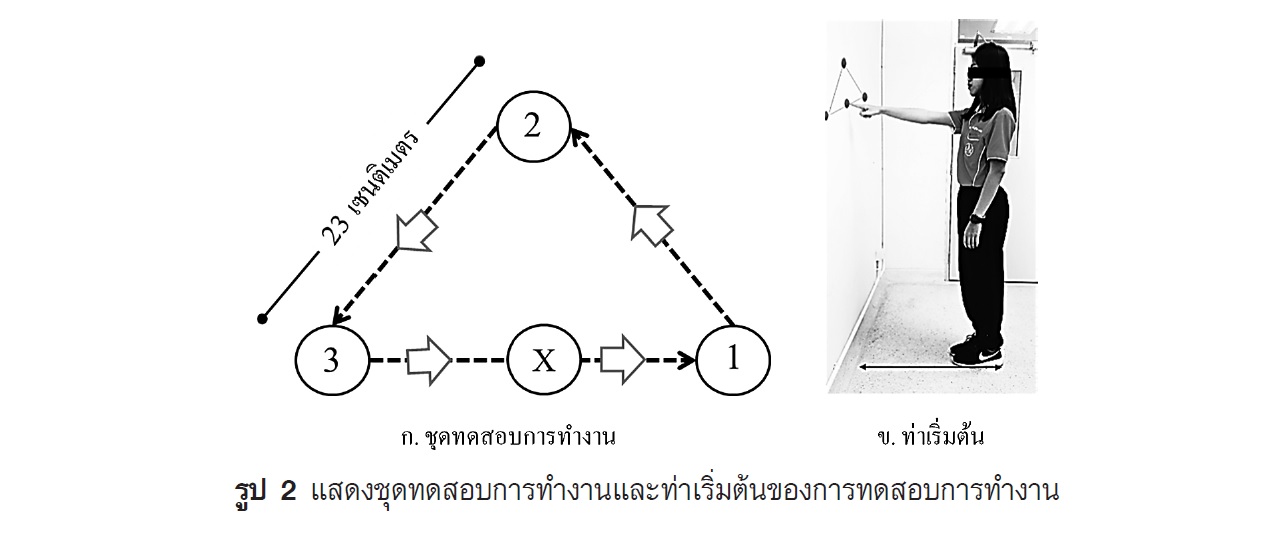TRAPEZIUS MUSCLE ACTIVITY DURING ABOVE-SHOULDER LEVEL TASK IN INDIVIDUALS WITH SCAPULAR DYSKINESIS
Main Article Content
Abstract
Scapular dyskinesis, an altered position and kinematics of the scapula, can lead to abnormal movement of upper extremity and increase the incident of shoulder injury.
Objective : To investigate muscle activity of Trapezius muscle in individuals with scapular dyskinesis during above-shoulder level task.
Methods : Twenty-eight participants, aged between 20-22 years, were divided into two groups. A scapular dyskinesis group (n=14) and control group (n=14). Surface electromyography (SEMG) was used to monitor upper trapezius (UT) and lower trapezius (LT) muscle activities. Participants performed a maximum voluntary isometric contraction (MVIC) and above-shoulder level task. SEMG was recorded during above-shoulder level task at 0, 10, 60, 120 and 10 sec after finishing the task. These EMGs were normalized and presented as %MVIC. A mixed ANOVA was used to analyze the differences of the %MVIC within and between groups.
Results : In comparision of the % MVIC at 0 and 120 sec, only the %MVIC of upper trapezius muscle in scapular dyskinesis group showed a significant difference (p <0.05). In addition, the %MVIC of lower trapezius in control group was significantly greater than that of scapular dyskinesis group (p <0.05).
Conclusion : The current study demonstrated that the lower trapezius muscle activity in scapular dyskinesis group was significant difference compared to the control group and the upper trapezius muscle activity was significantly higher over time.
Article Details
References
Bagg, S. D., and Forrest, W. J. (1986). Electromyographic study of the scapular rotators during arm abduction in the scapular plane. American Journal of Physical Medicine, 65(3), 111-124.
Cools, A. M., Witvrouw, E. E., Declercq, G. A., Danneels, L. A., & Cambier, D. C. (2003). Scapular muscle recruitment patterns: trapezius muscle latency with and without impingement symptoms. American Journal of Sports Medicine, 31(4), 542-549.
Cram JR KG, H. J. (1998). Introduction to surface electromyography, Gaithersburg, MD, United States. Aspen Publisher
Ekstrom, R. A., G. L. Soderberg and R. A. Donatelli (2005). “Normalization procedures using maximum voluntary isometric contractions for the serratus anterior and trapezius muscles during surface EMG analysis.” Journal of Electromyography and Kinesiology 15(4): 418-428.
Falla, D., Bilenkij, G., & Jull, G. (2004). Patients With Chronic Neck Pain Demonstrate Altered Patterns of Muscle Activation During Performance of a Functional Upper Limb Task. Spine, 29(13), 1436-1440. doi:10.1097/01.brs.0000128759.02487.bf
Falla, D., Farina, D., & Graven-Nielsen, T. (2007). Spatial dependency of trapezius muscle activity during repetitive shoulder flexion. Journal of Electromyography and Kinesiology, 17(3), 299-306. doi:http://dx.doi.org/10.1016/j.jelekin.2006.03.005
Huang, T.S., C.Y. Huang, H.-L. Ou and J.-J. Lin (2016). “Scapular dyskinesis: Patterns, functional disability and associated factors in people with shoulder disorders.” Manual Therapy 26: 165-171.
Huang, T. S., H. L. Ou, C. Y. Huang and J. J. Lin (2015). “Specific kinematics and associated muscle activation in individuals with scapular dyskinesis.” Journal of Shoulder and Elbow Surgery 24(8): 1227-1234.
Kibler, W. B., Uhl, T. L., Maddux, J. W., Brooks, P. V., Zeller, B., & McMullen, J. (2002). Qualitative clinical evaluation of scapular dysfunction: a reliability study. Journal of Shoulder and Elbow Surgery 11(6), 550-556. doi:10.1067/mse.2002.126766
Laudner, K. G., Myers, J. B., Pasquale, M. R., Bradley, J. P., & Lephart, S. M. (2006). Scapular Dysfunction in Throwers with Pathologic Internal Impingement. Journal of Orthopaedic & Sports Physical Therapy, 36(7), 485-494. doi:doi:10.2519/jospt.2006. 2146
Ludewig, P. M., Cook, T. M., & Nawoczenski, D. A. (1996). Three-Dimensional Scapular Orientation and Muscle Activity at Selected Positions of Humeral Elevation. Journal of Orthopaedic & Sports Physical Therapy, 24(2), 57-65. doi:doi:10.2519/jospt.1996.24. 2.57
Lertsinthai, P., S. K. (2015). “Comparison of Back Muscle Electromyographic Activity during Sideways Sitting Between Flat and Inclined Surface.” Thai Journal of Physical Therapy 37(2): 11.
McClure, P., A. R. Tate, S. Kareha, D. Irwin and E. Zlupko (2009). “A clinical method for identifying scapular dyskinesis, part 1: reliability.” Journal of Athletic Training 44(2): 160-164.
Oatis, C. A. (2008). Kinesiology: The Mechanics and Pathomechanics of Human Movement (Second ed.). India: Lippincott Williams and Wilkins; Second, North American edition (February 2008).
Poppen, N. K., & Walker, P. S. (1976). Normal and abnormal motion of the shoulder. The Journal of Bone and Joint Surgery, 58(2), 195-201.
Portney, L.G, and Watkins, M.P. (2008) Foundations of Clinical Research: Applications to Practice. Upper Saddle River, NJ, United States. Pearson Education


